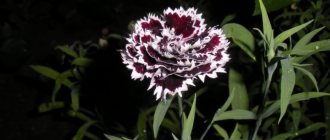Loading…
Loading…
Phloxes of unusually bright color are ideally suited for organizing flower beds. These lush flowering perennial plants are easy to care for. They look great and take root in the same area with other types of flowers, shrubs and herbs. This means you can create a flower bed with phlox of any type: mixborder, carpet, irregular or regular flower bed, group, parterre, border, array and ridge.
But their most important advantages are the flowering period and frost resistance.
Thanks to the huge number of types of phlox (about 60), for your home flower garden you can choose groups of plants that have different flowering periods. Thus, flower beds with phlox planted on the site will delight others with bright and unusual colors (aromas) from the first truly warm days of spring until autumn.
How to plant phlox in the garden
Since phlox belongs to the category of unpretentious plants, they can be grown in different places. Planting can even be done in containers and flowerpots, but they look best in a large array. And if you give free rein to your imagination and make a lot of flower beds with phlox of different shades: pink, white, purple, blue, crimson, you can make the landscape surprisingly bright and beautiful. But it is important to take into account the height of adult bushes, flowering time, and the nuances of the combination of foliage and inflorescences. For those who like to enjoy flowers in the morning and evening, chameleon varieties or those with white buds are more suitable; for decorating large flower beds or parks - one tone.
Having knowledge in landscape organization, with the help of decorative phlox you can create harmonious compositions in combination with peonies, daylilies, hydrangeas and other flowers.
Combination of phlox flowers in a flower bed with peonies
A perennial can create an original composition in the same bed with peonies, even though the latter are quite demanding of their neighbors. Varieties of peonies have different colors, remain decorative until mid-autumn, their carved leaves serve as an excellent background, which makes it possible to often use the crop in the landscape.
Attention! When planting phlox in the same place as peonies, you need to take into account the height of the plants so that they do not cover each other.
It is advisable to plant low-growing phlox next to lush peony bushes.
With daylily
The unpretentious daylily is often used in home gardens. It is perfect for landscaping flower beds and retains its attractive appearance until late autumn. It can be combined with almost all ornamental plants. For example, “Phlox paniculata” (Paniculata) looks great in the front garden with daylilies in fawn and pink shades, and the variety “Amethyst” will be an ideal neighbor for rich red daylilies.
When choosing a daylily as a neighbor, phloxes need to carefully select shades
Can phlox be planted next to roses?
Is it possible to plant roses next to perennials? This is a question that does not have a clear answer. Often the crop suffers from powdery mildew and can become a source of infection, so it is better to plant proven, mature and healthy phlox bushes in the rose garden. They will be able to decorate the landscape of the flower garden just when the roses have stopped blooming. The main thing is to correctly compose the composition and choose the appropriate color scheme. The varieties “Zefir” or “Alisa Freyndlih” are suitable for pink roses Home&Garden and Petit Trianon. Blue shades of Sedaya Dama, Arcanum, Blue Paradise will look good with yellow, cream or peach roses. And the purple variety “Aida” or “Miss Mary” will keep company with roses of any shade.
Paniculate phlox will be an excellent background for low-growing plants or a border for tall queens of the garden.
Comment! Only early varieties of perennials can bloom in a duet with roses.
Roses feel comfortable next to healthy phloxes.
Combination with hydrangea
Planting phlox next to hydrangea will be an excellent solution for the landscape of any flower garden. These plants are considered wonderful companions. When choosing a hydrangea bush for a front garden with a perennial, it is better to give preference to low-growing species with narrow leaves. Color scheme may vary. For example, the white caps of the Polar bear hydrangea will set off tall phloxes of lilac shades or show an interesting result in combination with varieties of similar shape.
Some varieties of phlox are very similar in appearance to hydrangeas.
What else do phlox go with?
Flowerbeds in the landscape of which this brightly blooming crop is present look great at any time of the year.
Perennials that bloom in spring are advantageous to plant on lawns, rock gardens and near borders. They go well with colors such as:
- dwarf irises;
- primrose;
- saxifrage.
It is advantageous to place next to summer-autumn varieties:
- lungwort;
- hosts;
- basilisks;
- astilbe;
- Siberian iris.
Phlox varieties Orange, Hochgesang, West will fit perfectly into the landscape of autumn mixborders. If the flower garden is located in a well-lit area, it is allowed to plant shrub aster and helenium in it.
Phloxes are combined in the garden with almost all decorative flowering crops.
Of the bulbous crops, those that do not need annual digging are the best to act as a neighbor:
- crocuses;
- Chionodoxa;
- daffodils;
- scillas;
- early varieties of lilies (Prado, Vermeer, Renoir).
If your knowledge in the field of landscape design is low, then in order to avoid mistakes in the combination of shades, it is better to use plants that bloom at different times, for example:
- splinters;
- dwarf wormwood;
- edelweiss;
- Chistets;
- young.
How to achieve greater effect
When the ideal flower garden has been compiled and the most suitable neighborhood has been chosen, the color combination of perennial plants can become a little boring. In this case, you can diversify the shades of the main plant. Using the root division method, it is possible to free up areas of soil in the flowerbed and plant phloxes of lighter or, on the contrary, darker shades.
A wonderful option is to play with light and the shaped arrangement of phloxes in the flowerbed. Gradient planting of different shades of flowers will allow you to admire the flowerbed for a long time and constantly discover new motifs.
Phlox in a garden with shrubs
The chic bushes of this plant can reach a height of up to 1.5 m. Its stems are straight and even, and the inflorescences consist of numerous flowers (up to 90 pieces), which can form an ideal composition for evergreen shrubs: camellia, holly, cistus, cistus, choisia and lavender . Dwarf barberry and spirea would be an excellent option for a neighborhood. In addition to being an attractive combination, the bushes will serve as a border for phloxes, which bend strongly towards the ground during rain.
Important! When creating a landscape with a combination of a flowering plant and a shrub, the perennial is planted in front of the crown.
Reproduction
There are several ways to propagate perennial phlox:
- Seeds;
- Stem, leaf and root cuttings;
- By division;
- By layering.
Growing from seed is usually used for creeping species. The dense, dark green seeds are collected in the fall before the seed pods open and peeled. After this, they are sown in the prepared soil, laid out at a distance of 5 cm and sprinkled with a layer of earth. After the snow melts, the seeds begin to germinate. The strengthened seedlings can be planted.
A common and effective method is cuttings. Shoots from 5 to 15 cm are separated along with part of the rhizome, placed in moist soil and left in a greenhouse. The cutting spends three weeks in a warm, dark room to take root.
One of the easiest ways to reproduce is division. This is how the popular species, awl-shaped phlox, is often propagated. To do this, the bush is dug up and divided into parts, which are planted in different holes, carefully plunging the roots into the soil.
Subulate phlox can be propagated by layering. To do this, the stems are bent to the ground. After the plant has finished flowering, the stem is fixed and covered with peat. By autumn, the sprouted shoot becomes a full-fledged flower that can be replanted.
Basics and rules, what to plant phlox with in a flower bed, ideas with photos
There are several rules for choosing a neighbor for a perennial, and it is advisable to follow each of them without fail:
- Choice of colors. The delicate color of the crop goes better with plants with blooming white flowers and inflorescences with a dark purple palette. Yellow, cream, peach shades will add aristocracy to the landscape.
- Flowering period. It is advisable to plant phlox next to perennials, which will bloom with them in tandem. Any variety of perennial hosta will be a good neighbor for phlox.
- When organizing the landscape, it is worth taking into account the structure of plant root systems. It is important that the neighbor’s roots do not interfere with the proper nutrition of the perennial.
- When planting a companion, it is necessary to leave enough space for the phlox to circulate air.
Selection by color scheme
The color palette is rich and varied.
However, these plants completely lack yellow pigment. Breeders around the world have been trying for several centuries to develop a variety that has at least a faint shade of yellow. But all attempts end in failure. However, phlox can delight the eye with all shades of red, purple and white. Phloxes are combined with flowers that have light, light shades. In this case, they become lush and airy. The proximity to flowers of pale yellow, bluish and cream motifs emphasizes sophistication and aristocracy.
Important! Dark, rich neighboring plants will give phlox depth and sensuality.
What other flowers should I plant next to phlox?
The list of flowers that will look good against the background of culture is very large. To summarize, we can note the following pattern:
- A landscape with early flowering awl-shaped plants looks good against the backdrop of ground cover perennials: carnations, cat's paw, aubrieta, periwinkle.
- Asters, geraniums, speedwells, and bluebells will become companions for summer-blooming bushes.
- A landscape with summer-autumn varieties can be supplemented with astilbe, lungwort and basilisk.
- Thunberg barberry (Berberis thunbergii) and spirea are planted with late-blooming phlox.
Delphiniums, lupins, poppies and helenium will give a beautiful combination to the garden bed with perennials. A composition with monarda, sage and agastache will be interesting and fragrant. Various varieties of geraniums get along well with phlox.
Comment! In addition to flowers, ornamental cabbage, ferns and hostas can be planted next to phlox.
Rules for composing flower arrangements
Visiting floral exhibitions, people are amazed by the imagination and talent of the craftsmen who create real masterpieces even from ordinary-looking plants. Composing an exquisite flower arrangement requires not only ability and inspiration, but also knowledge of the basic rules of floristry.
Before you start creating a flower bed, you need to draw or draw up a design in your mind, and based on it, create a composition. A flower that has a contrasting shade to the main background is usually chosen as the main point.
Imagining what the flowerbed should look like, divide it into 8 parts of the same size.
To make the composition look bright and interesting, plants of different heights and colors are used.
The bouquet seems weightless if light colors are combined; dark ones make it heavy and lush. To give harmony to the flowerbed, you need to choose the right colors. The palette should be restrained, not flashy. Shades of the same paint are always successfully combined; contrasting tones in a certain sequence look good, starting with red and orange, and ending with blue and purple.
Flower garden care
There are no special rules for caring for a flower garden with phlox. The culture is unpretentious and requires minimal effort when growing. It is planted in open ground in early spring or autumn (during the first two weeks of September). After planting, provide regular watering and loosening. Fertilize about five times per season with mineral mixtures. As the buds dry and wither, they are cut off or torn off.
Advice! Phlox planted in spring easily take root and bloom the same year.
Flowers do not tolerate dry soil and require abundant watering
Transfer
It is necessary to divide and replant phloxes. Over the years, the rhizome grows and becomes like a hummock in which a lot of dying tissue has accumulated. New shoots of the plant appear on the periphery, and the center weakens over time and almost does not bloom. A transplant for rejuvenation is carried out once every 5-7 years, but it can be done a little more often. The transplant procedure can be carried out in spring, summer or autumn.
For spring replanting (April-May), the soil is prepared in the fall. To do this, holes are dug, the distance between which is at least 50 cm for tall varieties and 20-30 cm for low-growing varieties. The pits are filled with compost and fertilizers, and the acidity of the soil is reduced with the help of lime. The additives are mixed and poured with water. Shoots 10-15 cm long are placed in pits for transplantation. In this case, the buds for renewal must be covered by 4 cm. After this, a layer of compost is poured, everything is compacted and covered with a layer of mulch of 10 cm.
You can replant phloxes in a blooming state. In this case, the seedling must be carefully dug up so that the root system is not damaged. In summer, abundant watering is required so that the roots do not dry out and take root safely. The pits need to be prepared in advance: 2 weeks before transplanting. The advantage of dividing at this time of year is that mistakes are eliminated when choosing certain varieties.
Phlox can be replanted in the fall until mid-September. Usually during this period the top part of the seedlings is cut off, which promotes better rooting. If phloxes do not have time to take root before the cold weather, they will die in winter.
Bearded irises
Bearded irises are very common in landscape design. They combine several classes and are the largest group. They differ in height, which must be taken into account when using them in landscape design.
It is very interesting to create an iradarium in the garden. This is a flower garden that is built on a composition from one crop. Its dimensions correspond to the size of an average flower bed.
Irises are in demand in garden landscape design. With the help of successful iris combinations, your garden design can be completely transformed. In the iridarium you can place several varieties of irises of different colors. Plantings are carried out in groups, the gap between them is filled with small stones. At the same time, do not forget to leave free space, which will be filled by overgrown plants as they grow.
Important! It is not recommended to plant plants in rows; it is better to plant asymmetrically, like on an alpine hill. The boundaries can be either fuzzy or limited by stones of various sizes.
The boundaries can be either fuzzy or limited by stones of various sizes.
Interesting. The Iridarium will look harmonious even on a retaining wall.
You can supplement such a flower garden with the help of cereals, but you should not be zealous; 2-3 groups of cereals are enough. Ceramics or various forgings are used to decorate the iridarium. These can be vessels of various shapes, original benches and bridges, a carved fence.
How to plant irises beautifully? Additional decorations of the iridarium are very important - the flowering period of irises is not very long. The rest of the time, the flower garden will simply delight the eye with greenery. Therefore, the introduction of additional elements is necessary.
Bearded irises amaze with their beauty and diversity - they can be either one-color or two-color, two-tone, iridescent and bordered. With their help, it is easy to decorate the landscape, creating a bright flower garden from it.











